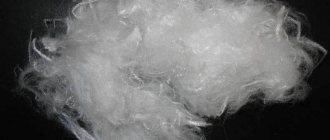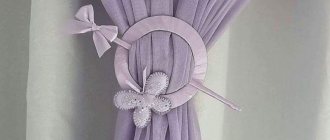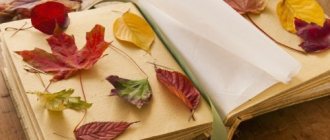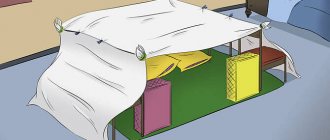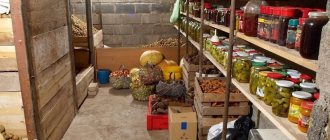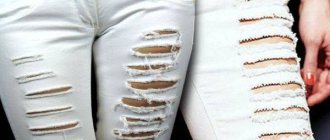DIY sofa pillows
Sofa cushions will add curb appeal to any home. With this decorative element you can not only decorate your home, but also please your loved ones with a stylish and original gift. Creating such a surprise with your own hands is not so difficult. All you need, besides materials and tools, is a little perseverance, imagination, and the desire to make a beautiful thing. A master class on sewing cushions for a sofa will help you do it correctly and accurately.
Size
A set of pillows of several sizes will look stylish: small, medium and large. All these options fit perfectly into the interior of one room. Products whose side size or diameter is 30-40 cm are considered small, medium size is 40-70 cm, large size is 70 or more centimeters.
Form
Sofa pillows come in different varieties. One of the most popular types is “dumka”. This ordinary pillow has a square, round and rectangular shape, and has small dimensions: sides from twenty to forty centimeters. It can be used as a soft pad on the seat of a chair or to the back. Modern little thoughts can be of absolutely any type - from classic to the form of fairy-tale characters, animals, bottles, vehicles.
The classic shape of a thought is square, round, rectangular. But there are other, unusual and interesting options:
- Sectional - parts are connected using side inserts of different hardness, used on wicker furniture.
- Turkish - with oriental patterns, folds at the corners, rounded shape.
- Quilted - the model is decorated with decorative stitching on one or two sides.
- Oxford - decorated with a border and tassels.
- Dumka-roller is the most common type.
- Non-standard shapes - flowers, letters, animal shapes, etc.
Filler
The sofa cushion should be soft and pleasant to the touch
When choosing the filling of an accessory, you should immediately exclude old fabric items or cotton wool. These materials clump over time and form hard lumps. Optimal options: synthetic winterizer, fibertech, foam rubber, holofiber, down. Foam rubber or synthetic pillow filling is characterized by the absence of allergic properties and softness.
Textile
The first stage in sewing a thought is the choice of fabric. The material must be durable. Beginners are advised to choose simpler fabrics, for example, chintz, cotton. When making pillows, fabrics such as silk, linen, felt, denim, calico, flannel, and upholstery are often used. Sometimes an old knitted sweater or bulky pullover is used to create knitted pillows
Each type of fabric used has its pros and cons:
- Linen – does not cause irritation, is durable, “breathes”. Minus: wrinkles easily, a little stiff, shrinks quickly.
- Silk is durable, pleasant, wear-resistant (can withstand washing at 110 degrees), and allows air to pass through well. Cons: expensive, wrinkles quickly.
- Chintz is breathable and easy to care for. Disadvantages: short-lived, afraid of high temperatures, wrinkles and shrinks easily.
Denser fabrics have their own characteristics. These include fert, jeans, bike.
- Felt – a wide color palette, easy to work with, no front or back side, composition: 90-100% wool. Disadvantage: afraid of high temperatures, can lose shape if washed incorrectly, and pills appear.
- Denim fabric (denim) is durable, breathable, environmentally friendly, fashionable. Disadvantages: shrinks after washing, hardens, fades.
- The bike is hypoallergenic, low cost, practical, pleasant to the touch. Disadvantage: inelastic, difficult to sew (falls off).
Preparing to sew
Since soft decorative objects are often moved from place to place, dropped, and children play with them. Therefore, to create them you need to choose durable fabric, safe padding with an elastic texture that does not change its shape under physical influence. Sewing beautiful sofa cushions consists of several stages: choosing the material, selecting the appropriate padding and sewing itself.
Choosing fabric
Choosing fabric for thinking is the very first and most important stage. The main quality of the selected material should be strength. If you still have no idea how to sew a pillow for a sofa with your own hands, then it is best to choose simple fabrics: cotton or chintz. Also commonly used fabrics: felt, silk, linen, upholstery material or calico. For knitted pillows, it is best to use old knitted sweaters or unnecessary bulky jumpers. An important factor in the material used should be color fastness and texture density so that the padding material does not fall out.
Pros and cons of different types of fabrics
Natural fabrics:
- Calico fabric is easy to care for, has a light and breathable texture. Cons: sensitive to high temperatures, can shrink, easily wrinkled and short-lived material.
- Silk is distinguished by its strength and wear resistance, can be washed at a fairly high temperature (about 110 degrees), and is a highly breathable material. Cons: wrinkles easily, the price is quite high.
- Linen fabric is hypoallergenic, breathable, and washable. Cons: shrinks quickly and wrinkles very easily, the material itself is harsh.
For the interior:
Jeans, flannel and felt are fabrics of denser origin, which have their own characteristics:
- Jeans or denim is a breathable and quite durable fabric, the colors look very stylish and fashionable, and are environmentally friendly. Cons: highly susceptible to fading, hardens and shrinks after washing.
- Fleece is a budget fabric, pleasant to the touch and practical to use, hypoallergenic. Disadvantages: during sewing it frays a lot, which causes certain difficulties, and the fabric is absolutely not elastic.
- Felt - there are no back and front sides, which simplifies its use, a large range of colors, containing 90-100% wool. Cons: pills may appear after washing, it is afraid of high heating temperatures, both during washing and during steam treatment, and if washed incorrectly, it loses its shape.
You may be interested in sewing an invisible hidden zipper into skirts
Additional Information! When sewing decorative pillows, a combination of fabrics is allowed; one side can be linen and the other silk. It looks unusual and beautiful. You can also create your own patterns from many scraps of different fabrics. This type of needlework is called patchwork.
Curtain to match the style of pillows
Filler selection
Just sewing a pillowcase is only a small part of the work done; it still needs to be stuffed. There are two types of padding:
- Natural filler (plant or animal origin).
- Artificial filler.
The advantages of natural fillers, in this case of animal origin, are their long service life, practically no caking, and maintain good sanitary and hygienic properties. The only thing is that such material is rarely used when sewing decorative pillows, since they are not fluffed like sleeping pillows. Such fillers include feathers and down.
Fillers of plant origin are often used for medicinal purposes or for people with certain types of allergies to down or synthetics. The filling can be: bamboo, medicinal herbs, buckwheat husks or hop cones. Cons: this material has the ability to rot, become damp and even rot, so it requires very careful care.
Original design
Artificial filler: holofiber and synthetic fluff. These are the most recommended materials that will not lose their elasticity over the years. Cotton wool, padding polyester, etc., these materials are absolutely not suitable for stuffing decorative pillows, as they tend to quickly clump and cake.
For pillows in a children's room, it is best to use silicone granules; also, this type of material does not get wet and is hypoallergenic.
Important! Dummies with artificial filling can be easily washed in a washing machine, eliminating accumulated dust, which is not permissible with filling made from natural materials.
Necessary items for sewing:
- Scissors;
- Fabric and padding, zipper (for certain types of pillows);
- Sewing machine (can also be sewn by hand);
- Tailor's pins and needles;
- Meter or simple ruler, chalk;
- Threads, pattern on cardboard or instructions;
- Iron.
Step-by-step master class on sewing pillows
All materials are prepared, tools are collected, you can start sewing the pillow:
- We decide what size and shape the thought will be, let’s say a square, 50x50 cm.
- On the laid out fabric from the wrong side you need to draw two 50x50 squares, adding 2-3 cm around the perimeter for the seam.
- Folded squares with the front part facing inward should be pierced with pins along the perimeter so that the fabric does not move out and cut out.
You might be interested in this: Simple patterns and sewing procedures for Baby Bon
Furniture cushion
The next stage is stitching the prepared parts:
- You need to start sewing by stitching 3 sides of the cut pieces, without removing the pin so that the fabric does not slip. Retreating the same 2-3 cm that were left in reserve.
- Bend the resulting seams to one side and iron them thoroughly, then turn them right side out.
- Fill the resulting pillowcase with the selected filling and stitch the remaining side, bending the seam inward.
Large sofa cushion
Cushions for sofas of impressive size require good skill and acquired practice during sewing. The sewing algorithm is exactly the same as for standard products that were described earlier. It is enough to increase the dimensions of the finished pattern to the required parameters. Large sofa cushions can also be made under furniture, covered with upholstery furniture textiles.
Crocheted and knitted pillows: ideas, photos, patterns
The ability to crochet or knit makes it possible to make beautiful pillow covers with your own hands. Beautiful patterns will create a unique design and make the room cozy.
Various knitting patterns are used to knit cushion covers. These can be openwork patterns, crocheting from motifs, knitting or purling with knitting needles.
You can also knit pillows of various shapes, for example, in the form of animals, different geometric shapes, etc.
Cushion covers can be knitted from leftover yarn. If you have a lot of little colorful balls and you don't know where to put them, cushion covers are a good idea for usefully recycling leftover yarn.
Let's look at some crochet cover ideas.
One of the simplest and most common patterns is the granny square. These pillows are made in a retro style, reminiscent of the old days, when grandmothers could find many similar products in their houses.
Crochet pillow with granny square pattern
Below is a knitting pattern.
Scheme of the granny square pattern
Pillows with openwork patterns look romantic. These pillows will decorate any room. The intricate pattern does not require any additional decor; such pillows are beautiful in themselves. The pattern is called "pineapple". Below is a diagram, following which you can knit such a beautiful romantic pillow.
Crochet pillow cover with an openwork pattern. Knitting pattern for an openwork crochet pillow cover.
The next pillow is knitted with a flower pattern. For experienced knitters, knitting such a cover will not be a problem. Looks impressive.
Crochet pillow with knitting pattern
You can also knit simple but beautiful cushion covers with knitting needles. Cable patterns are a classic pattern that never goes out of style. The braid pattern can be found not only on knitted sweaters, scarves, but also on pillows. A well-chosen tone of thread for the pillow will make the interior luxurious.
DIY pillows Knitted pillowcases with knitting needles: braid pattern Knitted pillowcases with knitting needles
Below are patterns for knitting patterns with braids.
Pattern for knitting patterns with braids Patterns with braids: patterns Knitting patterns with braids with patterns
You can also knit openwork patterns, checkerboard stitches and other patterns with knitting needles. Pillows in the form of a cushion look original. Knitted pillows are most appropriate in the winter season; they will warm you with their warmth and give a cozy atmosphere to your home.
DIY pillows: covers knitted with knitting needles Knitting pillow: checkerboard pattern DIY bolster pillow
The nuances of knitting and crocheting pillows
If a woman knows how to knit, she can independently create an original item for her home. Knitted pillows will look great in almost any interior: both country style and modern. Knitted covers will help update old sofa cushions and give them a new look.
Craftswomen make pillows in the form of toys or figurines. The scope for imagination is huge. Thus, figures in the form of large snakes or turtles are very popular. There are options with voluminous flowers and leaves.
Knitted cushions for the sofa are made by knitting or crocheting. You can use a knitting machine.
Recommendations for knitted items:
- When working, wool, cotton, and synthetic threads are used. But it’s better to opt for acrylic - it washes better.
- You can use plain threads, or you can make an original mosaic.
- The color and shape are selected in accordance with the sofa or chair on which the pillows will lie.
- Lace covers in the form of a napkin combine well with a base of bright shiny fabric.
- Pillowcases made from different knitted motifs are more suitable for children's rooms.
- For beginner knitters, there are a lot of knitting patterns and their detailed descriptions on the Internet.
- Variegated motifs like “Granny Square” will allow you to use the remains of colorful yarn from other products.
- Experienced knitters recommend making pillowcases separately and then putting them on the cover.
- Knitted lace can be attached to the cover with buttons or lacing.
- If the cover is solid, then it is better to make it with a zipper along the seam.
- Knitted covers can be washed by hand or in the washing machine on a delicate cycle. To dry, straighten it onto the fabric.
For a beginner in knitting, pillows are an ideal option: they will allow you to learn techniques without making complex calculations.
To knit a beautiful decorative cover, just choose a pattern, select threads and follow the instructions. Over time, experience will be accumulated, and it will be possible to create original models.
How to sew a painted pillow with your own hands
One of the most interesting methods of decorating decorative items is painting on fabric. To do this, you don’t have to have artistic abilities; it’s enough to use stencils. There is a special paint on sale that is not washed out of the fabric fibers even during washing.
To create such a product with your own hands, you can use the batik technique. Use leaves of outdoor plants as a stencil.
First you need to make the pillow itself; it can be a standard square shape. Then sew a pillowcase on it. There can be many pillowcases and all of them are different - you will never get tired of such a thing.
Don't be afraid to sew simple items. To do this, it is enough to have the most basic skills and a sewing machine.
Required tools and materials
To make the main cover, it is better to choose a thick, non-staining fabric that will last a long time.
For a full cycle of work you need:
- Materials for making a pillow: fabric, pattern, filling, scissors, thread, pins.
- Materials for making a pillowcase: natural light fabric, scissors, thread. Buttons or zipper.
- Stencils, paints, scissors, parchment, hammer, plant leaves.
To decorate a case with designs with plant motifs, there is no need to specifically look for such stencils: clover leaves, plucked with stems, will do.
In autumn you can collect fallen leaves. Forest fern leaves will look good. The main requirement is that leaves and trunks must leave clear imprints on the fabric.
It is better to take siliconized parchment (for baking).
Step by step guide
To make a simple pillow with sides 40x40, you don’t need to take a pattern—just use a regular ruler.
Step-by-step guide to making a model with painting:
- Two squares of the required size are cut out of the fabric. They overlap each other, are pinned together and swept away.
- The squares are sewn together along the perimeter. There is a hole left on the side for stuffing to the required size.
- The cover is turned inside out and filled with filler.
- The hole for turning inside out is sewn up with a hidden seam - the main product is ready.
- Two squares of the required size are also cut out of the fabric for the pillowcase.
- The square of fabric is laid out on a hard surface.
- A plant leaf is placed on the fabric, with parchment on top. The sheet is beaten heavily with a hammer. The leaves secrete juice, which is absorbed into the fabric and forms an imprint.
- The pillowcase is sewn together. For fastening, it is better to use a hidden zipper, or buttons.
- A decorative pillowcase is placed on the pillow. The product is ready.
The pillowcase, where plant juice was used as paint, can be washed. This must be done with a delicate detergent in warm water.
Painting with acrylic paints on fabric
In order to create a more durable paint coating, you can use acrylic paints. They are selected in advance depending on the type of materials to be worked with.
The operating technique is as follows:
- A design is applied to the fabric in several layers. You can use a stencil. Details are drawn.
- The image is fixed with an iron through a thin sheet of paper - the drawing is ready.
Before you start working with paints, if you want to create a clear drawing, you should stock up on contours. They will prevent the paint from spreading across the fabric.
Mattress for sitting and/or lying on
We immediately divide them into preferred ones: hard, medium, soft.
Everyone has their own preferences, but I like very soft options that you can fall into like a cloud. Older people prefer hard options. Although some young people also sometimes order hard options.
Now let's see how we will apply it. If you want to make a mattress for some benches that will stand at the dining table
, then a very soft option will not work, it will not be comfortable. You need to choose either the middle option, or better yet, the tougher one.
Lounge areas - places to relax
, where you want to dissolve in a lying or reclining form, it is better to take medium softness or very soft. We often make such options for hookah areas or attics where people gather for an imposing rest with a low seating height of 20-30 cm.
Thickness of comfort!
Let's say you want to make a mattress for a bench, in general, a thickness of 5 cm will be quite enough. In my opinion, foam less than 5cm is pointless as you feel the hard part of the base of the bench itself. For example, kitchen corners are often made with a foam thickness of 2-3 cm. After 30 minutes of sitting in such a corner, the 5th point begins to ache and asks to be moved to a softer sofa. But more than 10 cm also makes no sense.
A completely different matter is a mattress on the windowsill or hand-made sofas on which you want to read a book, watch TV, or surf on a tablet. In this case, we recommend a thickness of 10-15 cm. Moreover, it is best to make a sandwich. I think you’ve seen how mattresses made in several layers are advertised; such a mattress pie is created for a reason. This gives a certain level of foam subsidence under different loads, and as a result, the spine completely relaxes.
Mattresses for the lounge area should start from 15 cm, we recommend 20-25 cm as the optimal solution. This is due to the fact that most likely you will put it on the floor, and there are 2 important aspects:
- it will be hard to get up
- the floor is often draughty
In any case, tell us your goals and objectives and we will definitely choose the best option for you. Our phone number is 8 (495) 230-12-48
Upholstery reupholstery
Covering the module is not a labor-intensive process, but requires care. First, you need to take into account that you will need two covers for pillows: internal and external. One closes the module structure, giving it a complete look, the second performs a decorative function. The first cover is made of coarse textile, characterized by good strength and density. The second fabric should also be dense, but also beautiful, fitting into the interior.
To make the process easier, you can rip open the old cover and, if there is no zipper, add an allowance. Having ironed the material, it is measured so as not to buy excess fabric, then the required amount of material is purchased and cut out in compliance with the direction of the grain thread. You should not add allowances other than those that already exist: the fit of the textile should be as tight as possible: sliding of the textile or its sagging is unacceptable, as this will lead to the formation of folds and loss of attractive appearance.
If desired, the cover can consist of more than just textiles. Sometimes a layer of synthetic padding is added to it, connecting it to the upholstery with decorative stitches. Often the cover is decorated not only with stitching, but also with finishing piping or cord.
Choosing a pillow for a sofa is a topic that worries many people. Having a good foundation, you don’t want to throw away furniture just because the modules are worn out. Repairing pillows will change the style of the interior and extend the life of the sofa.
An example of self-upholstery of a sofa (restoration of soft parts, replacement of upholstery fabric and strengthening of the main furniture frame) is in the video.
Cushions on a sofa are an integral part of the interior. The combination of design colors speaks about the subtleties of taste of the owner of the house. And the shape characterizes the personal characteristics of the owner. Handmade rollers will fill your home with coziness and will certainly delight your guests.
Sofa cushions provide comfort and coziness and help place color accents in the interior
How to sew a pillow for a sofa with your own hands
If an experienced needlewoman is able to sew a pillow without much difficulty, then beginners need to know the principles and sequence of work. The first thing you need to do is prepare everything you need for work. Beautiful pillows for the sofa are made in two stages:
- Sewing the thought itself, working with the selected filler.
- Making a pillowcase or cover for it.
First you need to prepare a set of necessary tools and materials:
- sewing machine;
- dense fabric for the bedstead - satin, calico;
- stuffing;
- tailor's centimeter, pencil or chalk for marking fabric;
- scissors, needle, pins, thread.
- cardboard, pattern paper, diagrams, ruler,
- materials for decoration;
- hoops, special threads or knitting needles if you plan to do embroidery or knitted elements.
When all the materials and tools are collected, the idea of a sofa cushion is ready, you need to move on to the sewing process.
- You need to decide on the size and shape. Let's assume that the thought is square, 45x45 cm.
- Draw 2 identical squares on the wrong side of the fabric. Add 2 cm around the perimeter for seams.
- Fold the squares right side inward and pierce the lines with pins so that the fabric does not slip. Cut out every detail.
Next, everything needs to be sewn:
- Sew three sides, departing 2 cm from the edge of each. You can sew along pins; this will not interfere with the machine needle, but will prevent the fabric from slipping.
- Fold the seam allowances to one side and iron them, turn the napkin “face” out.
- Fill the resulting bag with filler, sew up the hole by hand, folding the seams inward.
Types of stuffing
The next question that faces those who want to make a pillow with their own hands is what to stuff it with? Natural fillers include swan down, goose feathers, horsehair, sheep and camel wool, and even buckwheat husks. These types of fillers require special care. Due to their high cost, they are mainly purchased for those pillows that will be used for sleeping. Decorative ones are mainly stuffed with synthetic fillers:
- Sintepon. The leader among synthetic paddings. It replaced foam rubber, unlike which it breathes due to its special fibrous structure. Synthetic filler is lightweight, does not cause allergies and is easy to care for.
- Holofiber. Almost weightless material that allows moisture and odors to pass through. Holofiber fillings are ideal for kitchen pillows.
- Latex filler. It is obtained from foam rubber. The filler holds its shape well, so it is often used to stuff special orthopedic pillows for people with poor health.
There is also a separate type of filler - comforter. The material consists of small balls that quickly regain their shape after pressing.
Materials: what old things are suitable
How to sew a decorative pillow if there is no fabric blank? Take old things that are no longer needed, but will make beautiful pillowcases. Suitable:
1 Shirt. Stylish pillowcase with an interesting clasp. A good flannel shirt is very pleasant to the touch, and sleeping on it will be a pleasure. You can make an interesting hipster pillow from old plaid shirts and a cheeky one from denim ones.
2 T-shirt. An almost finished pillowcase that just needs to be stitched on both sides. You can make such a pillow with your own hands even without a pattern.3 Sweater. An old, soft, warm sweater can still serve you well. Just before making the pillow, make sure that the fabric is not itchy. Otherwise it will be impossible to sleep on it.
When the semi-finished product has been found or you have bought the fabric, you can start sewing pillows for the sofa with your own hands.
How to choose a shape for a future pillow
Not only its beauty and originality, but also its practicality depend on the shape of the pillow; in order to choose the right shape, it is worth considering the following points:
- pillows that are planned to be used as accessories can be sewn in the shape of a rhombus, heart, triangle, flower, etc., then they will look beautiful and give the interior a special coziness;
- if the pads are needed in order to use them to increase the comfort of hard furniture, you should start sewing with a cover, the dimensions of which must correspond to the parameters of the surface of the piece of furniture for which the accessory is being sewn;
- It is better to make accessories in the form of pillows fluffy (stuffed), because a flat decoration will not look impressive;
- for furniture it is better to sew flat pillows, they will be more comfortable and will not slip out from under the person sitting;
- You should not use pillows of geometric and delicate shapes on one piece of furniture, they will look disharmonious.
How to choose the right fabric?
Cushions for sofas are sewn from high-quality fabric, which during processing holds its shape and retains its appearance. The material must be hypoallergenic, environmentally friendly, wear-resistant.
The list of suitable materials:
- chintz;
- cotton fabric;
- felt;
- bike;
- tapestry;
- silk;
- atlas;
- linen;
- calico, etc.
It is better to choose covers for sofa cushions from dense, wear-resistant material that allows you to retain the filler and prevent granules from spilling out. The fabric dye must be moisture-resistant and hypoallergenic. To decorate a sofa, you can sew a series of pillows from different materials in a single color scheme or combine materials in one pillow. You can prepare 3-5 products of different sizes from upholstery material. The shades and texture of the covers should match the color scheme of the sofa group.
When selecting materials, optimal combinations for different styles are taken into account:
- for interiors in a classic style, combinations of blue, brown, gray, and dark green are suitable;
- in rooms in Provence and country style, fabrics with bright colors, elegant floral and geometric patterns are optimal;
- eco-style rooms are decorated with pillows made of fabrics with national ornaments, natural motifs and textures;
- For high-tech, minimalism, modern, and art deco styles, plain fabrics with matte and glossy surfaces are optimal.
Types of pillow designs
After the pillow is ready, it is worth decorating it. There are several decorating methods that you can use.
Denim pillow
Old jeans can still be used if you make pillowcases out of them. Even if they are torn or frayed, they are suitable for hemming.
The jeans are already decorated with fringe, zippers, and various pockets. If you have several pairs of jeans, you can use separate flaps, which makes it possible to make drawings.
This material is dense and reliable; they can be filled with any filling, including loose stuffing. The pillowcases will not tear and can easily withstand washing.
Items of clothing
Old things are the best stuffing for pillowcases, as they can be used even if they are very worn.
Depending on the type of clothing, their functions may differ significantly:
- Shirt. The shirts have buttons and loops that take the place of a padlock. It is best to take flannel shirts, which are pleasant to the touch and can resist wear and tear when washed.
- Sweaters. A wool sweater, from which you can make a pillowcase, will help create a warm atmosphere in winter. The tight knitting and beautiful weaves can hold back any fillers.
Satin ribbons
Silk satin ribbons are a convenient material that allows you to quickly make a pillowcase. The weaving technique is similar to that used to make baskets or pie tops.
You can combine different colors and shades to create interesting designs. With sufficient skill and tight weaving, you can create a dense base suitable for different fillers.
Patchwork technique
A frequently used technique in design. It can be provided at the sewing stage and a pillowcase can be made from individual elements. But, if a standard pillow was made from a single-color solid fabric, the flaps can be glued on afterwards. For this, fabric glue like Moment Crystal is used. It withstands washing well and does not lose adhesion over time.
For decoration you will need pieces of fabric, which should be placed on a single canvas and glued, you can also sew them with a small stroke. This technology can be extended not to the entire pillowcase, but to small areas.
Application
The technology is similar to the previous one, but the result should be more attractive in the end. Individual pieces of fabric are sewn or glued in such a way as to create a beautiful picture.
There are 2 types of application:
- Flat. In this case, individual pieces are simply applied to the pillowcase and sewn. After this, you get a smooth picture without volume.
- Three-dimensional. This technology creates a flat picture with additional frills, bells and other decorations.
Seal
You can contact an organization that provides fabric printing services. But if you plan to make something handmade, you can do it yourself. It is enough to find thermal transfer paper that allows you to apply a design to the fabric with an iron.
Main features of decorative pillows
Modern decorative home pillows have long ceased to comply with certain canons and sewing rules.
In their creation, you can use a huge number of techniques and materials, giving the final form the most intricate ideas.
Their size can be either excessively large or very small, depending on further operation and the nature of use of such products.
Quite often, too voluminous and wide pillows act as part of the furniture during gatherings with friends or when children play on the floor.
In this case, they act as small ottomans and reliably protect from cold and drafts.
Modern needlewomen have long abandoned standard square or round shapes. Now a modern decorative pillow is any geometric shape, soft animal, flower or even a long shaped cushion.
Each of them must clearly correspond to the room and furniture for which it is intended. Such soft products will become appropriate not only on sofas, but also on beds and armchairs for a comfortable position on them.
The color should match the style of the room and the furniture upholstery. In the nursery, you are allowed to deviate from these principles and sew this decor of any color and brightness.
The material for sewing can be absolutely anything and has no fundamental importance in manufacturing.
It is best to use natural dense fabrics that are easy to clean and quite unpretentious to constant use.
Very often, when sewing, the issue of hygiene is taken into account, and several pairs of pillowcases are additionally created, which can be easily changed and washed as needed, without damaging the filling inside each time.
Often the covers are created with convenient bow ties, buttons, zippers, or knitted from wool and yarn.
DIY sofa pillows
A huge assortment of sofa cushions does not exclude the lack of search results for the required products. When choosing them, you have to take into account several factors; it is not so easy to find options that fully match in size, shape, shade, style. In addition, mass products can be beautiful and convenient, but a priori they are not original or exclusive. Housewives with minimal knitting and sewing skills will be able to make a sofa cushion with their own hands and create unique masterpieces.
This type of craft will provide several benefits. Making decorative pillows allows you to:
- bring your creative ideas to life;
- decorate the interior with original items;
- find a use for unnecessary consumables;
- save costs.
Decorate your interior with an original handmade pillow
Many women have creative abilities that often go unused. If you have great ideas that need to be implemented, creating decorative pillows will be an ideal field for implementation. Any skills can be useful in this handicraft: sewing, modeling, knitting, artistic painting.
Hand-made pillows are an ideal addition to the interior. Shapes, sizes and textures are selected taking into account its specifics. Eliminates the risk of dissonance and inconsistencies
The design of the product will precisely meet personal requirements for comfort, which is also important.
In every home there is a collection of unnecessary things that are a pity to throw away and are difficult to repurpose. Many of them can be used in making pillows. Old clothes, leftover yarn, lace, buttons, etc. will be used.
Pillow decor with lace and buttons
There are two important psychological advantages of this needlework. The creative process calms you down, distracts you from everyday worries, and gives you positive emotions. Handicraft is an ideal educational method. A mother who is passionate about crafts can easily instill such an interest in her daughter, which contributes to the child’s creative development.
Making pillows allows you to avoid spending money from the family budget on purchasing these decorative items. Moreover, such handicrafts can become a source of additional, main income. Nowadays handmade products are at the peak of popularity. There will definitely be buyers for beautiful, unique sofa cushions.
From fabric
Undisputed leaders, perhaps because sewing will take much less time than knitting.
Cute bows
There are many variations of different types and sizes. I don’t mind bows, but some pillows are so good that even I wasn’t indifferent.
Cute bows
In my opinion, it’s a good idea for beginning craftswomen: it’s easy to make and looks good.
Variations on the theme of bows
With lace
Romantic lace will help to slightly enliven the strict design of the room. It is better if there are few of them so that the pillows do not look like an alien element.
Cute romantic pillows
With ruffles and frills
Many people consider this way of decorating pillows to be old-fashioned. Well, that’s their business, and you are free to choose any decoration option. You can limit yourself to a modest frill around the edge of the case, or you can go all out!
If you like ruffles and frills
Patchwork
If you don't have a sewing machine, this is not a reason to refuse a pillow made using the patchwork technique. You can also sew it by hand (our grandmothers sewed blankets!), it just takes a little more time.
A sewing machine is an absolute help in work
Choose cute models from large fragments, there are a lot of them too! For example, like this. Quilting is not necessary, but if you want, why not?
These covers can be sewn by hand
For those who have already mastered the basics of this technique, it will not be difficult to make more complex options. If fabric supplies allow, you can also sew a rug - you will get an excellent set in the same style.
What a beauty!
And if you are planning to amaze everyone with an extraordinary execution of traditional techniques, complement the patchwork with appliqué or buttons.
If only patchwork is not enough
Application
The scope for creativity is literally limitless: even beginners can create uniquely beautiful cases!
Start with simple options
The application does not have to be complicated; even the less labor-intensive options look decent.
Very nice
Well, when you get the hang of it a little, you can move on to more complex models.
Pillows for the cottage
With tassels and pom-poms
The ideal option is to give a new look to an existing pillow: just sew tassels or pom-poms onto it (surely everyone knows how to make them!). It seems like a small thing, but overall it looks different, prettier.
Quick decor for a pillowFlower pillows
Lately, people in handicraft circles have been talking only about them, but they left me indifferent. It seems beautiful and easy to make, but I wouldn’t want one for myself, despite all the cries of fashion.
Fashionable pillows
Embroidered
I know how to embroider, but I am still far from real mastery. There is only one problem - lack of free time. If you have enough of it, your home can be decorated with stunningly beautiful pillows!
The embroidered pillows are adorable!
Embroidery fascinates me; there is not a single pattern that I would not like to repeat!
I like them all!
Hand embroidery in itself looks luxurious, and if you complement it with beads or voluminous appliqué, you get real masterpieces!
This is skill!
Even sequins, if used in moderation, will be a good addition to some models. True, it is advisable to use them only as a decorative item - lying on such a pillow will not be very pleasant.
When sequins are in place
Well, if you simply adore beads, beads, sequins and other rhinestones, pay attention to these chic cases. Embroidery will take a lot of time, but it’s worth it, you must agree! Luxury cases
Luxury cases
Materials: filling and upholstery
Any modular pillow consists of filling and upholstery. The filler is the basis of the module; the upholstery covers the structure, giving it a holistic look.
To ensure that the pillow is elastic, but at the same time not too hard, manufacturers use a special material that forms a module. The following is used as a filler for the volumetric module:
- springs of dependent and independent types (designs with springs in horizontal and vertical positions, connected and not connected to each other);
- polyurethane foam (a budget elastic filler that looks like a sponge in sheet form of different thicknesses);
- a combined “sandwich” of several layers of polyurethane foam or a duo of a spring block and foam rubber;
- artificial latex (durable and expensive material that can withstand heavy loads without loss of quality);
- natural latex (the most expensive and durable material, often a combined version with the addition of coir to obtain an orthopedic effect).
Each type of filler is designed for a certain weight and service life, so if there is a question about changing pillows, you need to take into account the purpose of the furniture.
Spring options are interesting because they can be of a connected design or an independent type, when each spring is packaged in a textile case and functions independently. Moreover, the mat connection is created by connecting the spring covers.
Foam rubber structures are solid sheets of various modifications. Some roll into a roll, others are denser, so they cannot be wrapped, but they are resistant to bending and retain their original shape for a long time.
Coconut chess (coconut fibers) are quite coarse and represent a hard layer of small thickness (about 3 cm). If padding polyester or holofiber is added to the design, their layer is even smaller.
Manufacturers use different materials for the top of the product. As a rule, this is quite dense furniture textiles. The most common types of upholstery are tapestry, chenille, and flock. Unusual upholstery material options include Korean upholstery with a velor texture, called “Chinchilla”.
Types of pillows
There are an unlimited number of types of pillows, different shapes, sizes and purposes. Duma can look not only like a classic pillow, but also like a fairy-tale character, a car or an animal. Several main types used in decoration:
- A cushion is a small pillow, the second name of which is dumka, often used not only as an accessory, but also as a soft cushion under the head during daytime sleep.
- Sectional - consists of several volumetric inserts sewn together with ribbed inserts, in appearance it resembles sewing in a patchwork style.
- Turkish - often decorated with currency exchangers and tassels, the shape is slightly oblong, the embroidery on the fabric is reminiscent of oriental patterns.
- Quilted - comes in various shapes: rectangular, oval, round or square. A distinctive feature of this pillow is the quilted surface of the cover.
- Oxford - features additional stitching around the perimeter, which separates the border without padding. The piping accompanies the pillow around the entire perimeter.
Oxford pillow
Schemes and drawings
Beautiful pillows will organically fit into the interior, provided they comply with the overall design of the room. By adhering to generally accepted rules, you can achieve better design results.
Optimal stylistic combinations:
- classic interiors, antique do not limit the wide choice of shapes and textures;
- country, Provence - bright colors with variegated patterns, rich tones of fabrics;
- ethnic style – national patterns, motifs;
- minimalism, modern style, hi-tech, art deco - plain material is most appropriate.
DIY decor should harmoniously continue the overall design idea of the room.
Pillows that repeat patterns, textures of bedspreads, furniture upholstery, curtains will harmoniously complement the decoration with frills and tassels in accordance with the finishing of the details. The base of the element can be made of ordinary, durable material without decoration.
You can sew the product using standard patterns and drawings. Traditionally, pillows are made in the form of rolls, squares, and rectangles. Non-standard solutions provide their original version in the form of letters, figures of funny animals, flowers, or hearts.
With a zipper
Scops Owl
Square
Patchwork style

